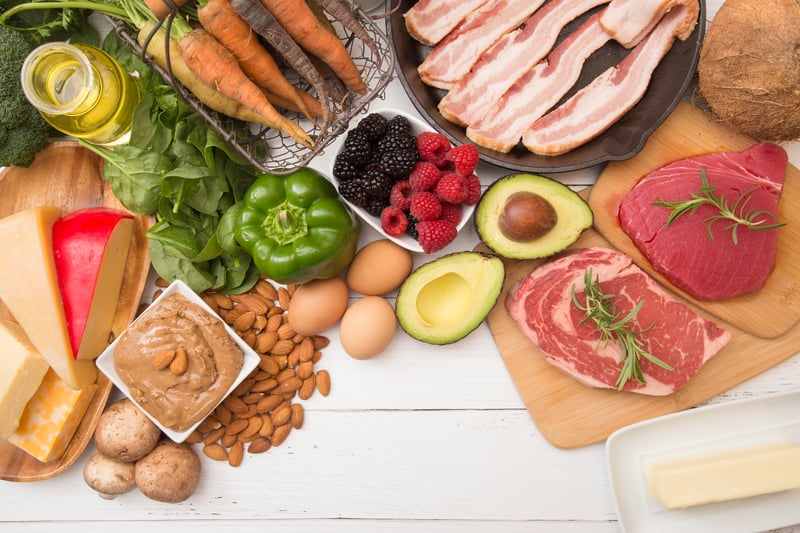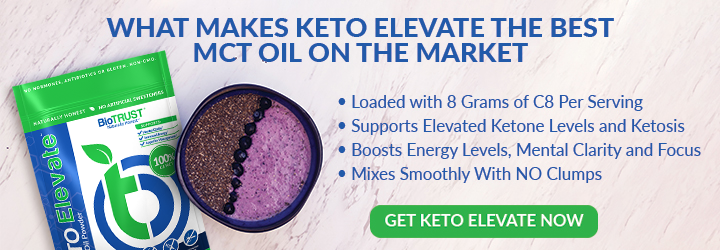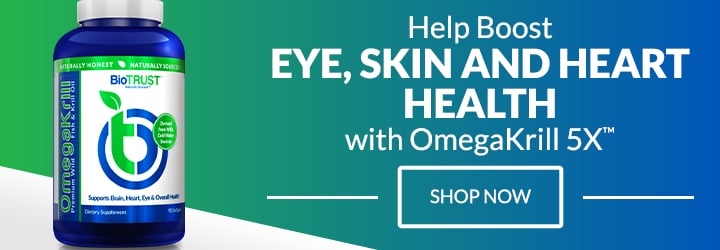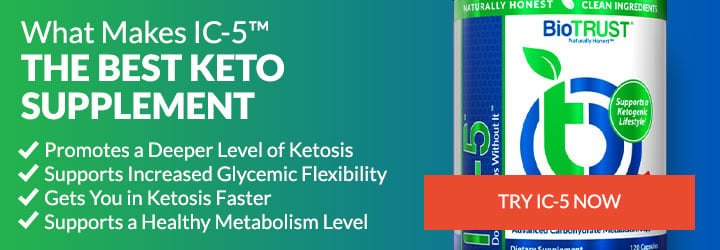See the Top 14 Common Nutrient Deficiencies on the Keto Diet

Why aren’t you getting results on keto? Are you looking to optimize physical and mental performance using keto? Are you concerned that your keto diet may be depriving your body of all the nutrition it needs? Are you battling the “keto flu” or struggling to “keto adapt”?
These are all important questions. While keto can be a healthy and effective approach, it can result in a host of nutrient deficits simple because it’s highly restrictive. Dig in with me below to discover the most glaring and common nutrient deficiencies. You’ll also learn how you can fill those gaps with whole foods and the most appropriate, best keto supplements.
Let’s get to it!
Increased Restriction = Increased Likelihood of Deficiency
Generally speaking, the more restrictive your diet, the greater the likelihood that nutrient deficits will arise. This is particularly true when you severely restrict any single macronutrient and eliminate entire groups of nutrient-rich foods. Such is the case with keto. This diet places a very low ceiling on carbohydrate intake and subsequently eliminates nutrient-rich foods like whole grains, legumes, fruits, and starchy vegetables (e.g., tubers). It even puts severe limits on non-starchy vegetables.
[Bear with me, briefly, for a short aside…There’s no debating the popularity and virality of the ketogenic diet. But just because “everybody’s doing it” doesn’t make it right. Don’t get me wrong. A ketogenic diet has applications (potentially radical, life-altering applications), and there’s little question that our bodies were designed to be in nutritional ketosis intermittently. However, it could easily be argued that only a small percentage of the population would be best off on a highly restrictive ketogenic diet all the time or even for an extended period of time.]
Believe it or not, the popularity of keto makes the problem of nutrient deficits better and worse. On one hand, the commercialization of keto makes it quite a bit easier to find on-the-go, keto-approved meals and foods. On the other hand, you have more and more people taking a lazy approach. For example, they’re just eating a bunch of fats, some protein, avoiding carbs altogether, and trying to patch things up with the best keto supplements.
The reality is that to fill as many nutritional gaps as possible with whole foods, your keto diet needs to be dialed in. This involves a high degree of knowledge, thought, planning, and preparation. Just like any diet, even a well-formulated keto diet is subject to nutrient deficiencies. And the more restrictive or the lazier you are, the greater the likelihood that those gaps increase—in both size and number.
With all that being said, here are some of the most glaring nutrient deficiencies common with the keto diet. 1,2,3,4,5 You’ll also find out which foods can help cover these deficits. And as you go through, you’ll discover the gaps you need to fill with supplements. In other words, this is a guide to help you uncover the best keto supplements for you.
14 Common Nutrient Deficiencies on the Keto Diet
1. Sodium. Like we’ve talked about before, sodium isn’t the devil we’ve long been led to believe. And when you’re keto, you arguably need to pay even closer attention to your sodium intake.
On one hand, a well-formulated keto diet emphasizes eating whole foods while subsequently eliminating (or severely limiting) processed foods, the major dietary source of sodium. Plus, carbohydrate restriction increases the excretion of sodium (particularly during early adoption of a ketogenic diet). Many would argue this deficit in sodium (along with the other electrolytes mentioned below) is public enemy number one when it comes to the “keto flu.”
Generally speaking, it’s recommended to consume about 3,000 – 5,000 mg of sodium per day by adding salt (such as Real Salt®) to your meals and consuming bouillon or bone broth.
2. Potassium. Like sodium, potassium levels fall during the early phases of a keto diet. And if you’re not careful, you can remain low in potassium, since it’s primarily found in whole, plant-based foods. Potassium is critical for maintaining blood pressure, fluid balance, muscle contractions, and nerve function.
It’s generally recommended to consume about 2,000 – 3,000 mg of potassium per day. Fortunately, there are several keto-friendly foods rich in potassium, including:
- Spinach
- Kale
- Mushrooms
- Avocados
3. Magnesium. Like potassium and sodium, levels of magnesium also fall when starting a keto diet due to increased excretion. This is compounded by the fact that some of the best sources of magnesium are carb-dense foods like whole grains and legumes, which are off limits on keto.
This is bad news considering magnesium is involved in over 300 enzymatic reactions, is required by every cell in the body, and plays key roles in energy production, nerve and muscle function, metabolic rate, blood glucose management, protein production, and more.
Fortunately, there are some keto-friendly options high in magnesium (aim for 300 – 500 mg per day):
- Spinach
- Swiss chard
- Pumpkin seeds
- Oysters
4. Calcium. Although calcium deficiency is less common, it is another electrolyte flushed from the body during the early stages of the keto diet. So, it’s a good idea to make sure you’re consuming plenty of calcium as a part of a ketogenic lifestyle. The following keto-friendly foods are good sources of calcium (1,000 – 2,000 mg/day is typically recommended):
- Almonds
- Cheddar cheese
- Sardines
- Dark green leafy vegetables (e.g., kale)
- Broccoli
5. B Vitamins. Because of the restriction of whole grains, legumes, fruits, and starchy vegetables and the limitations on nuts, seeds, and vegetables, it’s not uncommon for keto diets to be deficient in certain B vitamins, such as thiamin, biotin, and folate. Inadequate consumption of B vitamins can lead to a variety of problems, affecting mood, energy levels, heart health, sleep, nervous system function, and more.
Some of the best keto-friendly sources of B vitamins include:
- Dark green leafy vegetables
- Organ meat (e.g., liver)
- Eggs
- Nuts and seeds
6. Vitamin C. When it comes to vitamin C, a powerful antioxidant that also plays a pivotal role in collagen production, your thoughts might go straight to citrus fruits, which are not part of a keto diet. Neither are strawberries, pineapple, or kiwifruit, which are also great sources of vitamin C. (The recommended daily allowance, RDA, for vitamin C is 75 mg).
All is not lost, however, as there are several keto-friendly, vitamin-C-rich foods to choose from:
- Bell peppers
- Broccoli
- Brussels sprouts
- Cauliflower
- Cabbage
7. Vitamin E. Even though there are plenty of keto-friendly foods that provide vitamin E (RDA is 15 mg per day), which is the body’s major fat-soluble antioxidant, it is a common micronutrient deficit among keto dieters. As mentioned, though, you have plenty of options, including:
- Dark green leafy veggies
- Sunflower seeds
- Asparagus
- Almonds
- Broccoli
- Bell peppers
8. Iron. Essential for hemoglobin formation (which is critical for transferring oxygen in the body), muscle function, brain function, and energy metabolism, iron is a somewhat surprisingly common nutrient deficit among keto dieters.
Beef is the best dietary source of iron because it is provided in a readily absorbed form (i.e., heme). However, non-heme iron can also be obtained from keto-friendly, plant-based foods, such as sesame seeds, pumpkin seeds, and spinach.
Generally speaking, the RDA for iron is 8 mg/day for men and postmenopausal women, 18 mg/day for premenopausal women, and 27 mg/day for pregnant women.
9. Iodine. Another nutrient often lacking in keto diets (as with most diets, actually) is iodine. This is a trace mineral essential for thyroid function. Instead of using chemically-processed, unhealthy iodized salt, you’re better off getting your iodine (150 µg recommended daily) from the following keto-friendly foods:
- Sea veggies (like kelp)
- Eggs
- Cheese
- Cod
- Tuna
10. Vitamin D. A concerning number of people have low levels of vitamin D. Suboptimal levels of vitamin D have been associated with weight gain, poor metabolic function, mood-related issues, poor heart health, cognitive decline, poor immune function, and more.
And to make matters worse, there are few dietary sources of vitamin D. Not surprisingly, as with most diets, a deficit in vitamin D is common with keto diets.
Hands down, the best way to support healthy levels of vitamin D (at least 2,000 IU/day for most) is to make sure you’re getting plenty of non-burning sun exposure complemented with regular consumption of the following keto-friendly foods:
- Oily fish (wild salmon, sardines, mackerel)
- Eggs
- Mushrooms
11. Vitamin K. In the same breath as vitamin D, we have to talk about vitamin K, which is essential to support healthy, flexible arteries, a healthy cardiovascular system, and strong, healthy bones. As with vitamin D, most people aren’t getting enough vitamin K (keto or otherwise). It’s important to make sure you’re consuming dark green leafy vegetables, which are the major dietary source of vitamin K1 (at least 70 µg/day) and meat, eggs, and fermented foods, which are the major sources of vitamin K2 (at least 32 µg/day).
12. Fiber. This may be the elephant in the room when it comes to nutrient deficiencies common with the keto diet. Considering that only 5% of the population (which, as a whole, is not restricting carbohydrate intake) meets the Adequate Intake (AI) for fiber, it’s no surprise that one of the most glaring nutrient deficits of a keto diet is lack of fiber. Fiber is found predominantly in many of the very foods (e.g., whole grains, legumes, fruits) that are taboo on a ketogenic diet.
Sure, keto dieters can rake up some fiber from nuts, seeds, and veggies to a degree. But, it’s challenging to hit the AI (14 g per 1,000 calories; or 25 g for women and 38 g for men) without exceeding the low carbohydrate ceiling and/or overconsuming calories and/or protein.
While some people (for instance, people with overgrowth of bad bacteria, visceral hypersensitivity issues, GI irritation/inflammation, etc.) may benefit from restricting fiber—at least for short periods—it’s hard to ignore the potential long-term consequences of inadequate fiber intake and its implications on digestive health, heart health, glycemic balance, longevity, weight and appetite management, and more.
Heck, a recent study published in the Lancet provided compelling evidence that higher intakes of dietary fiber and whole grains were closely related to lower bodyweights and reduced incidence of “fill-in-the-blank” non-communicable disease. 6
While racking up 25 – 40 grams of fiber on a very-low-carbohydrate diet can be challenging, it’s not impossible (particularly if you’re in the business of counting “net” carbs, which you may be able to do after keto adaptation).
Of course, you’ll be wise to consume as many nuts, seeds, and veggies as your keto constraints allow. Although it takes some monitoring and practice, you can also include various sources (e.g., green bananas, raw potatoes) of resistant starch, which goes largely undigested, and in the large intestine, act like a fermentable fiber called a prebiotic. Speaking of…
13. Probiotics and Prebiotics. Diet has a profound effect on the gut microbiome, and when you restrict carbohydrates to the degree that a keto diet does, you invariably affect the makeup of the gut microbiome, influencing the amount, composition, and diversity of gut microbes. 7
Because many types of gut microbes thrive on substrates found in carbohydrate-rich foods (like grains, legumes, and fruits), it’s not surprising that keto can have a “pruning” effect on the gut microbiome. While this can actually be highly beneficial in certain instances (e.g., overgrowth of bad bacteria; imbalanced gut microbiome), recent research suggests these shifts may be “unfavourable changes in gut microbiota, which might confer adverse consequences for long-term health outcomes.” 8,9
In simple terms, at some point, it’s probably a good idea to promote microbial diversity and proliferation by introducing prebiotics (such as fermentable fibers and polyphenols) and supporting the gut microbiome with probiotics, such as soil-based, spore-forming bacteria, which have been shown to be very effective at improving the body’s balance of gut microbes. 10
13. Omega-3s. The latest research suggests that few people—keto or not—are consuming an adequate amount of omega-3s. For example, in a recent study published in the journal Prostaglandins, Leukotrienes, and Essential Fatty Acids, researchers concluded that to achieve a desirable omega-3 index (a measure of the percentage of the omega-3s EPA and DHA in the membranes of red blood cells) of at least 8%, a person would need to eat at least three servings of fatty fish (e.g., wild salmon, sardines, anchovies, mackerel, etc.) per week plus an omega-3 supplement providing at least 500 mg EPA + DHA daily. 11
It’s important to point out that this minimum threshold means various long-standing dietary recommendations, including the American Heart Association’s advisory of two 3 ½-ounce serving of fish each week, fall short. 12
And speaking of falling short, NHANES (National Health and Nutrition Examination Survey) recently published a study looking at omega-3 fatty acid intake in the United States between 2003 and 2014. Overall, the results were dismal, especially in light of the recommendation cited above (13 ½ servings/month). Even the groups reporting the highest fish intake only consumed an average of 2 ½ servings of fatty fish per month, which falls considerably short of the AHA recommendation of 8 – 9 servings/month. A guideline that appears to be outdated and suboptimal in its own right. 13
So, What are the Best Keto Supplements?
There’s no question it would be ideal to get all these nutrients naturally from whole foods. Generally speaking, nutrients from food tend to be well absorbed. What’s more, nutrients rarely travel in isolation when whole foods are the vehicle. Rather, whole foods tend to conveniently package a cornucopia of complementary nutrients. This includes often overlooked yet highly beneficial nonessential compounds (like antioxidant phytonutrients, such as polyphenols).
While it’s arguably possible to consume a nutritionally complete ketogenic meal plan, it would take exceptional planning and preparation (and perhaps even stretching carbohydrate limits) to do so. 14 In simple terms, it would be the exception, not the norm.
The reality is that to address the nutrient shortfalls common with the keto diet, some supplements are likely going to be helpful. Given the information above, here are some of the best keto supplements to address nutrient deficits:
- Electrolytes. While a specific electrolyte supplement isn’t always necessary, many keto dieters find it helpful—especially more active people and folks who seem to be having a particularly tough time staving off the keto flu. Some of the more popular options among the keto crowd include NUUN tablets and LMNT Recharge.
- Multivitamins. Grabbing a multivitamin off the shelf at your neighborhood big-box store or even your local health-food store probably isn’t going to cut it. You need to know what to look for in a multi. Hit as many of the gaps listed above as possible and get the best forms of these vitamins and minerals for optimal absorption. Our top recommendation is Ageless Core energy-boosting multivitamin.
- Vitamin D3/K2. As mentioned above, most people fall well short when it comes to vitamin D. Considering there are so few foods sources, a vitamin D supplement is foundational for most people to complement their time in the great outdoors. You’ll want to make sure you choose a vitamin D supplement that’s paired with its partner vitamin K. But not just any K will do. You’ll want vitamin K2, preferably the MK-7 form.
- Prebiotics + Polyphenols. Typically, when prebiotics come up, most people think about various fermentable fibers. While those certainly fit the bill, polyphenols (found in various plant-based foods, like vegetables, fruits, herbs, and spices) pass undigested into the large intestine where they can help control opportunistic microbes and serve as prebiotic fuel for healthy bacteria.
- Probiotics + Prebiotics. A high-fat, very-low-carbohydrate diet (keto) can have a profound impact on the makeup of the gut microbiome. At some point, preferably sooner than later, you’ll likely need to support the diversity and composition of your gut microbiome.
- Omega-3s. The most recent research really stamps the long-standing message that omega-3 supplements are foundational for virtually everyone, keto or not. And while some may contend that the research is not conclusive on omega-3 supplements, the simple counter argument is that it’s becoming increasingly clear that we need even more omega-3s than previously thought (to really drive up the omega-3 index). My recommendation is OmegaKrill 5X, which has earned the IFOS 5-star rating, is a high-DHA formula, contains krill oil and Astaxanthin, and provides omega-3s in their natural triglyceride form.
This is why I’m a big fan of MetaboGreens, which combines 3 different prebiotic fibers (acacia, inulin, and beta glucan) with polyphenols from over 40 different superfoods (including organic chlorella and spirulina, turmeric, reishi, berries, and more) in a delicious energizing berry powder.
While there are many probiotics out there (and there’s not a one-size-fits-all option), I typically recommend Pro-X10, which combines prebiotics (to support the growth of probiotics) with probiotics (to support a healthy balance of gut bacteria) in a “synbiotic” formula. Among the six strains of probiotics in Pro-X10 is Bacillus subtilis, a heat- and acid-resistant, soil-based, spore-forming bacteria.
In all it glamor, the keto diet is not immune to nutritional gaps. And generally speaking, the more restrictive or lazier it is, the larger and more numerous those gaps are likely to be. In an ideal world, nutrient deficits would be covered with whole foods. While that is possible with a carefully-planned, well-formulated ketogenic diet, most keto dieters will need to address at least a few nutrient deficiencies with supplements.
I hope this has been a helpful guide to discover which deficiencies apply to you and which are the best keto supplements to fill your nutritional gaps so you can get the best results. I’d love to hear your feedback and any questions you have below!








